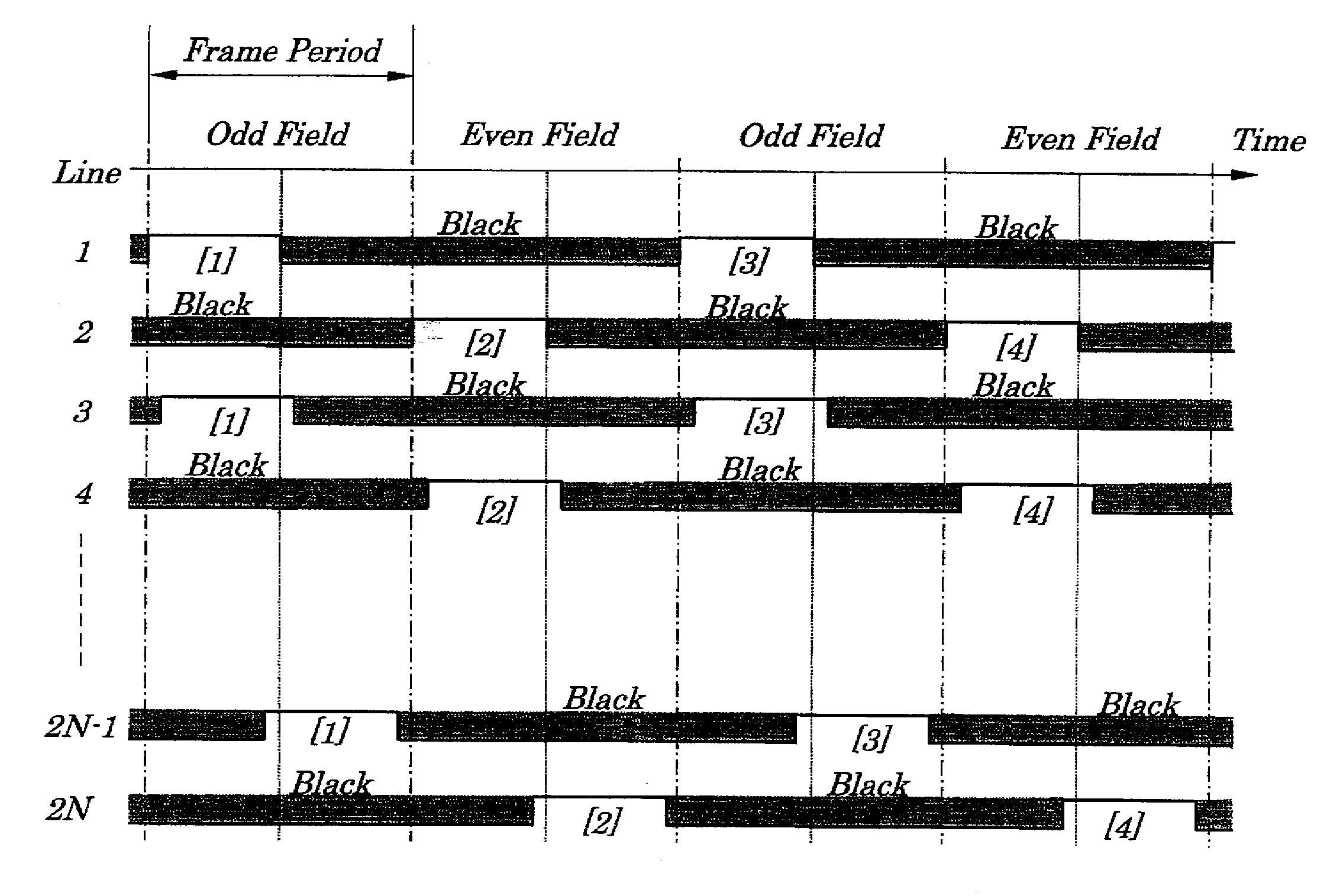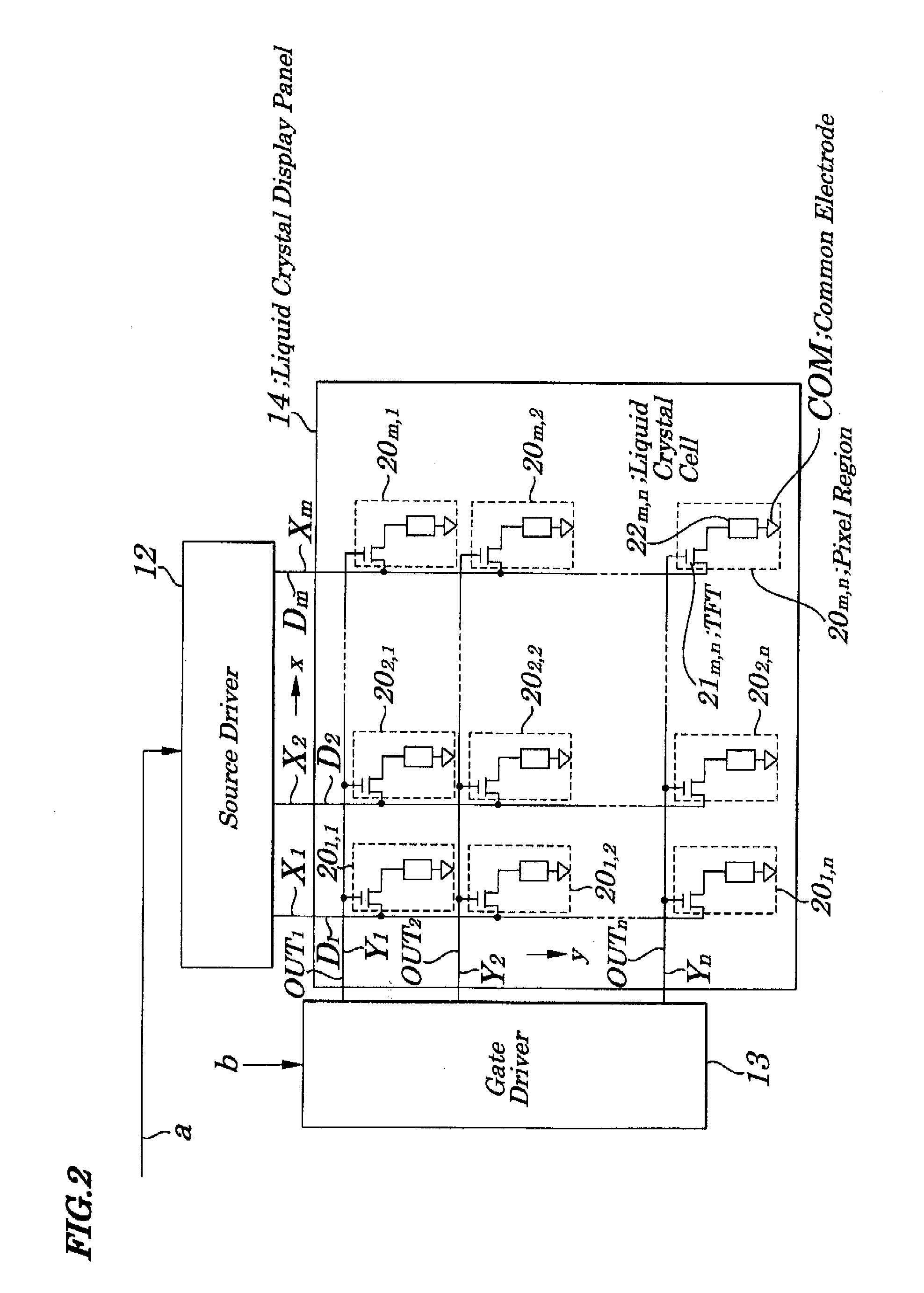Liquid crystal display device, driving control circuit and driving method used in same
a technology of liquid crystal display device and control circuit, which is applied in the direction of electric digital data processing, instruments, computing, etc., can solve the problems of increasing scale and power consumption, affecting the viewing experience of users, and the conventional liquid crystal display device described above has the following problems, so as to reduce the occurrence of a variation in luminance in an upper and lower portion of the display screen, and reduce the blurring of moving images
- Summary
- Abstract
- Description
- Claims
- Application Information
AI Technical Summary
Benefits of technology
Problems solved by technology
Method used
Image
Examples
first embodiment
[0053]FIG. 1 is a block diagram showing electrical configurations of main components of a liquid crystal display device of the first embodiment of the present invention. The liquid crystal display device of the first embodiment, as shown in FIG. 1, includes a timing controller 11, a source driver 12, a gate driver 13, a liquid crystal display panel 14, and a backlight 15.
[0054]FIG. 2 is a schematic diagram showing one example of electrical configurations of the liquid crystal display panel of FIG. 1. The liquid crystal display panel 14 is of a transmissive-type that permits light from the backlight to come in and in which, as shown in FIG. 2, a plurality of columns of data electrodes Xi (i=1, 2, . . . , m, for example, m=640×3), a plurality of rows of scanning electrodes Yj (j=1, 2, . . . , n; for example, n=480) so arranged as to be orthogonal to the data electrodes Xi, and pixel regions 20i,j. Each of the data electrodes Xi is formed at specified intervals in an x direction and re...
second embodiment
[0068]FIG. 11 is a time chart explaining operations of a liquid crystal display device according to a second embodiment of the present invention. FIG. 12 is a diagram explaining the inversion of the polarity of a voltage of data to be written in each of pixel regions of the second embodiment. FIG. 13 is a waveform diagram explaining operations of the liquid crystal display device of the second embodiment. FIG. 14 is a diagram showing another example of the inversion of the polarity of a voltage of data to be written in each of the pixel regions according to the second embodiment. FIG. 15 is a diagram showing still another example of the inversion of the polarity of a voltage of data to be written in each of the pixel regions according to the second embodiment. FIG. 16 is a diagram showing yet another example of the inversion of the polarity of a voltage of data to be written in each of the pixel regions of the second embodiment. Processing of the driving method employed in the liqui...
third embodiment
[0071]FIG. 17 is a time chart explaining a modified example of operations of the liquid crystal display according to a third embodiment of the present invention. The liquid crystal display device of the first embodiment is driven at a frequency being a half the frequency at which black is inserted ordinarily. In the third embodiment, in the case where the liquid crystal display panel and each component are driven at a doubled speed, one frame is divided into four fields and, by setting the frequency for switching between the odd and even field at a frequency being twice higher than a frame frequency, a doubled increase in frequency caused by an increased frame frequency can be offset by the by-half decrease in frequency achieved by the driving method of the present invention. Therefore, at an operational frequency of a signal of each component being the same as the conventional frequency for black insertion driving, a flashing frequency for black display and video display can be dou...
PUM
 Login to View More
Login to View More Abstract
Description
Claims
Application Information
 Login to View More
Login to View More - R&D
- Intellectual Property
- Life Sciences
- Materials
- Tech Scout
- Unparalleled Data Quality
- Higher Quality Content
- 60% Fewer Hallucinations
Browse by: Latest US Patents, China's latest patents, Technical Efficacy Thesaurus, Application Domain, Technology Topic, Popular Technical Reports.
© 2025 PatSnap. All rights reserved.Legal|Privacy policy|Modern Slavery Act Transparency Statement|Sitemap|About US| Contact US: help@patsnap.com



